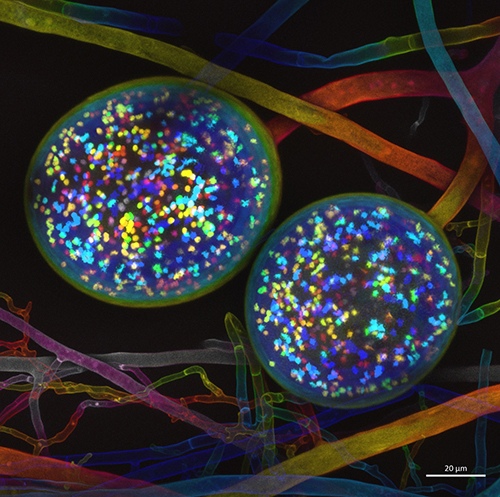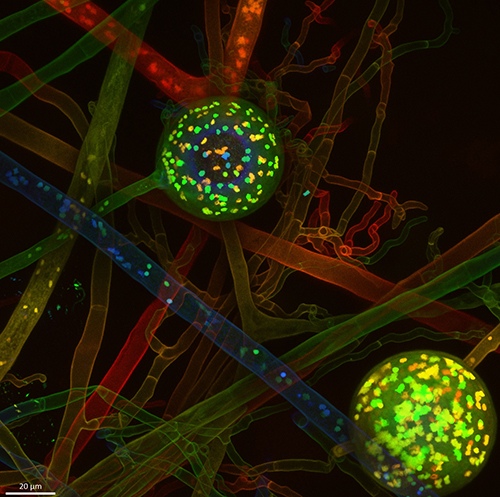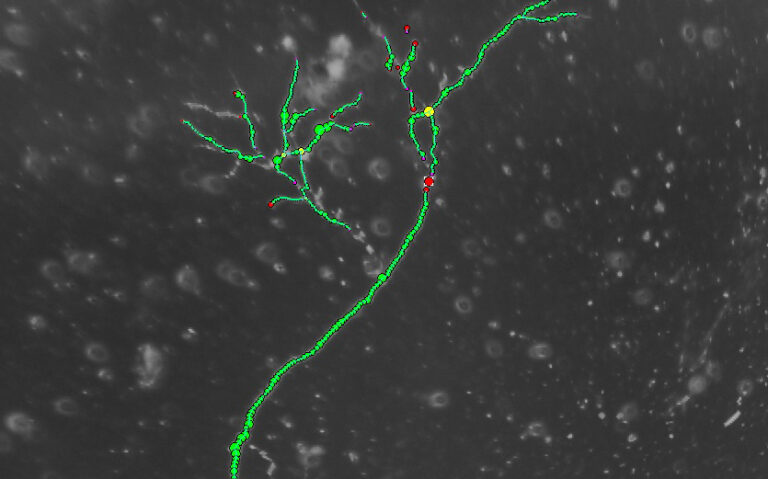Winner of 2020 Nikon Small World Photomicrography Competition
We are honored to have the chance to interview the winner of the 2020 Nikon Small World Photomicrography Competition, Dr. Vasilis Kokkoris. Dr. Kokkoris is an expert on Arbuscular Mycorrhizal (AM) fungi. In the process of unlocking the secrets of these fungi, which have strong, resilient survival skills and have existed on the earth for at least 600 million years, Dr. Kokkoris was able to capture stunning images. His winning image of multinucleate AM fungal spores and hyphae is the result of compiling more than 100 images from various focal planes. These crisp and detailed images allow us to see the highly complex organization and structure of the nuclei within the spores and hyphae of the fungus. In the following interview, you will be able to see his research through the images Dr. Kokkoris has provided along with his detailed explanations.

Q: Congratulations on your recent winning of the 2020 Nikon Small World Photomicrography Competition. Please share with us your winning image and the techniques you used.
A: Thank you very much, it is a great honor to be among the top winners of the 2020 Nikon Small World Photomicrography Competition and share the beauty of fungi with the world. Alongside the winning image I would like to share a couple more that were taken with the same technique and are amongst my favorites (Image 1 – 3). All the images, including the winning image, show hyphae and spores of a group of soil fungi, known as Arbuscular Mycorrhizal (AM) fungi. The images were created using confocal microscopy. Confocal microscopy uses fluorescence optics to reveal specific features of a cell. In the case of my images, I used confocal microscopy to examine the morphology and number of nuclei in the spores and hyphae of the AM fungi. Every single colorful bright spot demonstrates a single nucleus. Each image is a compilation of hundreds of images taken at a different depth of focus. That allows us to apply color-coding on the image, for example, blue colors are closer to the observer while red colors are further back. This so-called “pseudo-coloration”, creates the depth effect, allowing better image analysis for data extraction but also providing an incredible artistic effect.


Q: Please share with us your background and expertise which relates to your interest in producing micro-photography.
A: My passion for microscopy started from the age of 12 when my parents gifted me a toy microscope. It might have been a toy, but it could still magnify specimens up to 40 times. I would collect plants, insects, rocks, literally everything I could find to examine under the microscope. Later, and since the first day I had access to a biological lab (when I was an undergrad student), I would try to use microscopes even when that was not required for my research. The fact that I could explore a world invisible to the human eye excited me and still excites me. I would spend hours just looking at specimens and sketching what I saw on paper. Over the years I used a lot of compounds and dissecting scopes but recently, with my position as a post-doctorate researcher at the University of Ottawa and at the Agriculture and Agri-Food Canada Ottawa Research and Development Centre, I was able to access advanced microscopy equipment, such as confocal, scanning electron microscopy (SEM) and transmission electron microscopy (TEM). The moment I saw the images produced with these techniques I knew that I had to share the beauty of AM fungi with the scientific community and the public.
Q: Why are you drawn to the study of Fungi, especially Arbuscular Mycorrhizal (AM) fungi? What methods do you employ in your study, specifically the next-generation DNA sequencing?
A: From the time I discovered that first mushroom as a fascinated little kid, until now, I have tried to understand how fungi work and interact with multiple other organisms. The fungal kingdom has been a source of immense inspiration. Although when we think of fungi we usually think of mushrooms, rotten food and fungal infections, fungal contribution to our world is beyond imagination. Fungi shape our world and are found everywhere. They are decomposers and responsible for nutrient cycling. They can break down organic matter and hard to digest the material, for example, wood and cellulose, and return nutrients in a simple form to the environment where they become available to other organisms. Fungi are also extremely important for medicine. They naturally produce antibiotics that attack bacteria. Amongst them the famous penicillin and the important role it had and still has in human history. Beyond medicine, fungi also hold a crucial role in the food industry. Cheese, bread, beer, wine, and many more products are the result of fungal fermentation. Another important use for fungi and this is where my research is focused, is in agriculture. Fungal species that are animal pathogens can be used as pest controls. For example, they can attack specific insects that pose a threat to agricultural settings. But there is a specific group of fungi called “Arbuscular mycorrhizal (AM) fungi” that can associate with the majority of land plants and might hold the key for sustainable agriculture. As you can tell, the study of fungi is endless, multidirectional, serves humanity in great ways and is for sure exciting.
I employ multiple methods to study the AM fungi. Some are to assist with visualization and quantification of fungal traits and others are to unlock the genetic secrets they hold. I like to explore unconventional tools that were not destined to be used for fungal research, but that can provide precious information when implemented in this field. For example, in a recent study (Kokkoris et al., 2019a) I used neuron mapping tools to quantify the hyphal growth of AM fungi (Image 4). And in another study (Kokkoris & Hart, 2019a) I used tools that examine root morphology to quantify the presence of the AM fungi inside the roots. Recently I used advanced microscopy (Confocal microscopy and Scanning electron microscopy) to examine the nuclear dynamics of AM fungi as well as the architecture of their spores (Kokkoris et al., 2020). You see, AM fungi have incredibly unique nuclear dynamics. Their entire hyphal network is a single cell (what we call coenocytic mycelium) where everything is connected and thousands upon thousands of nuclei move bi-directionally like cars in a busy highway. In a similar manner, they accumulate hundreds of nuclei in every single spore, as you can see in the confocal images. The number of nuclei in their spores is so high that it is beyond comparison to any other fungi. If anyone is interested in learning more about the nuclear dynamics in AM fungi, they can take a look at our recently published review where we compiled all the available information (Kokkoris et al., 2020). A project that I am working on now aims to extract genetic information from single nuclei by using next-generation DNA sequencing. Such techniques can provide us with the complete genetic code of each organism. Having access to this code will give us great insight into the evolution and the function of these fungi, helping us understand better how they interact with the plants and under which conditions we should expect improved symbiotic efficacy.

Q: Please explain to us what Plant Symbionts are and the significance of them in the ecosystem.
A: It was not many years ago that we identified the importance of AM fungi, although they exist for at least 600 million years. AM fungi colonize the roots of most land plants and it is believed that they helped plants transition from water to land, an event that took place 500 million years ago. The synthesis of fungal and plant root tissue is called “mycorrhiza”. The word has Greek origin and is the combination of the words “μύκης” and “ρίζα” which translates to “fungus” and “root” and is highly descriptive of this unique co-existence. The symbiosis is so common that any root you might dig up from any environment, most likely will be mycorrhizal. In biology, the close interaction between two different organisms is called “Symbiosis”, another Greek term that means “to live together”. As such, a mycorrhiza is a symbiosis, and the AM fungi are considered plant symbionts. When we hear of a symbiosis our mind usually goes to a beneficial interaction, but this is not always the case. There are many types of symbiosis and they are defined based on the benefit or detriment that each of the interacting partners gets. For example, the little tick that got attached to my dog is also demonstrating symbiosis. In this case, the benefit is only for the tick since my dog is losing blood and might get numerous diseases. This type of symbiosis is called “parasitism”. In the case of mycorrhizas, the symbiosis results in a mutual benefit (both for the fungus and the plant) and this is called “mutualism”. In the mycorrhizal symbiosis, the fungus gets carbon from the plant and pays back with nutrients that are hard for the plant to obtain (especially phosphorus and nitrogen). But their contribution to the ecosystem does not stop with improved nutrient relations between the two partners, they protect their partners from multiple environmental stresses (e.g. salinity, heavy metal contamination etc.), allowing plants to grow in environments they would not be able to grow or thrive in otherwise. They also modify the physical soil environment by increasing aggregate stability and even affect plant interactions with other organisms, for example by protecting plants against pathogens or by affecting plant relations to pollinators.
Q: In your study, are there any phenomenon of fungi behavior that might alert us to such phenomena as the decline of the fungi population or something else?
A: Fungi seem to be very resilient with great survival skills and extremely efficient dispersal abilities. But there are still so many species that await to be discovered and described. Estimations suggest that there are more than 3 million species of fungi on earth while only less than 200.000 have been described to this day. It is therefore difficult to estimate how many species are endangered especially due to anthropogenic activities. For AM fungi, we know that soil disturbance, happening to great extent in agricultural fields (e.g. tilling, fertilization, fungicides) can reduce the native population. This is where commercial inoculants that contain AM fungal species come into play. We can add these products to restore the AM abundance in the soil, but as a recent practice, this needs more research to make sure it is not causing any unwanted consequences. For example, previous research I conducted during my PhD showed that the methods used to mass produce this fungi in the lab, can make them less beneficial to plants (Kokkoris et al., 2019a; Kokkoris & Hart, 2019a,b). Additionally, in the case of unwanted spread of the commercial AM fungi to natural ecosystems (what we call invasion) (Kokkoris et al., 2019b) there is the possibility that commercial AM fungi are not as beneficial as the local wild AM fungi on wild plants (Kokkoris et al., 2019c)
Q: You believe in pedagogy, an ancient form of Greek teaching. Would you please elaborate on what this philosophy means to you? Are formal reasoning and deduction included in this form of teaching?
A: The word “Pedagogy” has its origins in ancient Greece, and it means “to educate, teach manners and tutor youngsters”. Through centuries, pedagogy lost its full meaning and now mostly translates to “teaching”. To be more precise it means teaching to the test. The majority of modern educational systems are built in a way that favor very specific skills, such as efficient short term memory, competitive behavior and tolerance to stress, which are just a limited amount of skills that do not reflect the true abilities of an individual. What happens to creativity? What happens to morality? What happens to virtue development? Shouldn’t an educational system’s purpose be to help shape complete personalities? Education should not only challenge memorization skills. Besides knowledge transfer, it should also create favorable conditions for personality development. I strongly believe that we need to implement the use of a “philosophical teaching” approach in our educational centers. Aim to create an environment that promotes creative thinking and creative imagination. This can be achieved by individualizing the learning experience when possible, by inspiring and motivating students by showing honest passion and enthusiasm and to never stop learning and developing ourselves. For example, let us say that the students have to perform a biological experiment that requires a lot of effort to set up, requires repetitive measurements and is time consuming. Instead of making it a boring, useless experience and a hunt for high grades we could explain what one can learn from every single step. I am not referring to the biological meaning or the bio-chemical processes that might take place to the cell level. I am referring to the virtues that one can develop through the process. It can be the respect for the organisms used and respect for life, it can be the development of patience, the importance of order, the value and power of repetition, the necessity of cleanliness, the respect for time, the development of cooperation and sociability and so many more. There are fundamental differences between “smart” and “socially smart or empathic” or between “educated” and “ethical”. Pedagogy and philosophical teaching are the means that can bridge these differences and provide the ultimate service to our societies by shaping complete individuals. This applies both to teachers and students.
Q: Besides researching and teaching, please share with us any hobbies that also interest you.
A: I like to keep my mind and body busy. I like learning new things, whether it is a new athletic activity or acquiring a new skill or exploring actual or imaginary worlds through reading books. Most of all I have a passion for music. I love playing or composing music, although lately science has been keeping me too busy to do so. I am in the process of balancing my two major passions to a healthy and creative level. Hopefully soon, besides science and microphotography images I will be able to share some of my music as well.
Q: Please share with us your future plans for your research. In addition to your current study, any other subject that you would like to explore?
A: AM fungi will always have a place in my future research. Still so many unanswered questions about these important symbionts remain, and I am willing to uncover more of their secrets in multiple levels (genetics, physiology, morphology and ecology). Besides mycorrhizal fungi, I am interested in studying another group of fungal symbionts (again in a symbiosis with plants) called fungal endophytes. This group of fungi produce chemical compounds with high therapeutic value.
References
Kokkoris V, Miles T, Hart MM. 2019a. The role of in vitro cultivation on asymbiotic trait variation in a single species of arbuscular mycorrhizal fungus. Fungal Biology 123: 307–317. https://doi.org/10.1016/j.funbio.2019.01.005
Kokkoris V, Hart MM. 2019a. The role of in vitro cultivation on symbiotic trait and function variation in a single species of arbuscular mycorrhizal fungus. Fungal Biology 123: 732–744. https://doi.org/10.1016/j.funbio.2019.06.009
Kokkoris V, Hart M. 2019b. In vitro Propagation of Arbuscular Mycorrhizal Fungi May Drive Fungal Evolution. Frontiers in Microbiology 10. https://doi.org/10.3389/fmicb.2019.02420
Kokkoris V, Li Y, Hamel C, Hanson K, Hart M. 2019b. Site specificity in establishment of a commercial arbuscular mycorrhizal fungal inoculant. Science of The Total Environment 660: 1135–1143. https://doi.org/10.1016/j.scitotenv.2019.01.100
Kokkoris V, Hamel C, Hart MM. 2019c. Mycorrhizal response in crop versus wild plants (R Aroca, Ed.). PLOS ONE 14: e0221037. https://doi.org/10.1371/journal.pone.0221037
Kokkoris V, Stefani F, Dalpé Y, Dettman J, Corradi N. 2020. Nuclear Dynamics in the Arbuscular Mycorrhizal Fungi A Fungus That Carries Thousands of Nuclei in One Cell. Trends in Plant Science 2020. https://doi.org/10.1016/j.tplants.2020.05.002
We thank Dr. Kokkoris wholeheartedly for his candid and detailed explanation of his research and his interests. It is both educational and informative. We hope we will be able to hear more from him, both his music and research.
Dr. Kokkoris’ Website